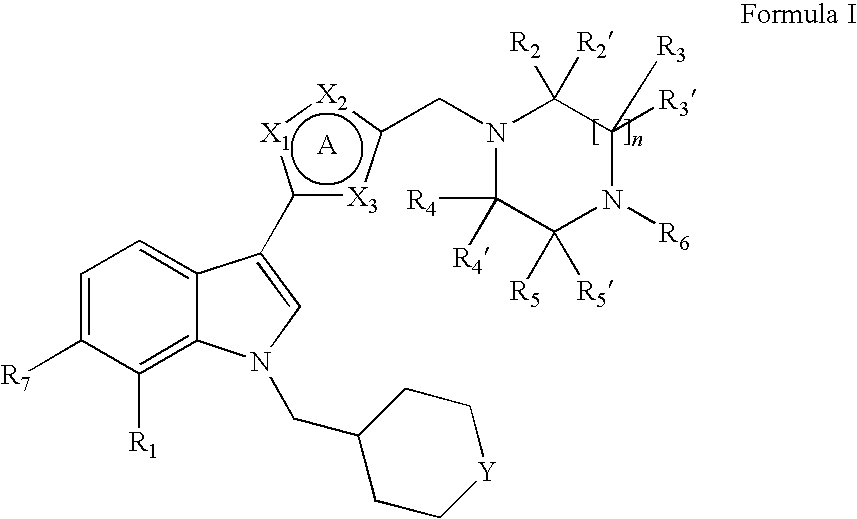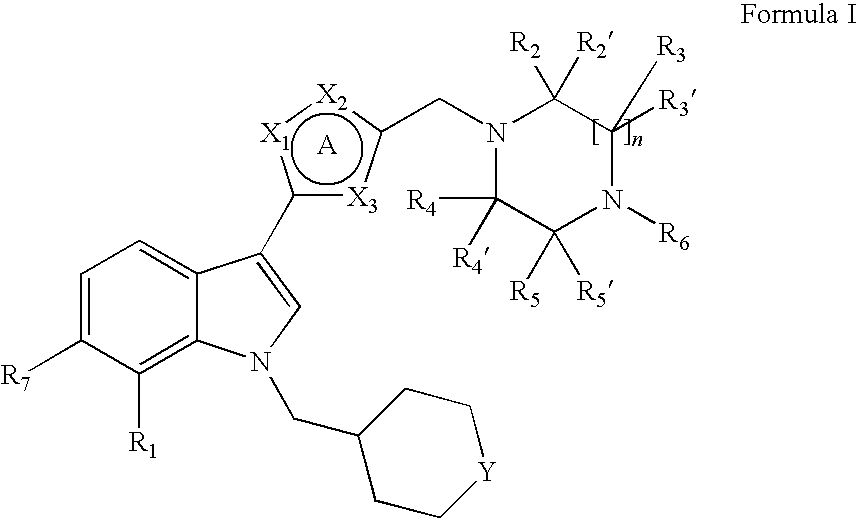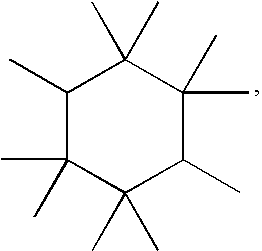Indole derivatives
a technology of indole and derivatives, applied in the field of indole derivatives, can solve the problems of respiratory depression and muscle rigidity, limited pain treatment, serious and potentially life-threatening side effects,
- Summary
- Abstract
- Description
- Claims
- Application Information
AI Technical Summary
Benefits of technology
Problems solved by technology
Method used
Image
Examples
example 1
3-({5-[4-(Carbamoylmethyl)piperazin-1-yl]methyl}-[1,2,4]-thiadiazol-3-yl)-7-chloro-1-(tetrahydropyran-4-yl)methyl-1H-indole, bis-hydrochloride salt
Step A: 7-Chloro-1H-indole-3-carboxylic acid
[0104]A solution of 7-chloroindole (7.1 g, 47.0 mmol) in dimethylformamide (60 ml) was cooled to 5° C. under nitrogen and trifluoroacetic anhydride (7.6 ml, 54.0 mmol) was added over 10 mins, maintaining the temperature below 10° C. The mixture was stirred at 5-10° C. for 2 h, then poured into water (600 ml). The resulting suspension was stirred for 15 mins and the 7-chloro-3-[(trifluoromethyl)carbonyl]-1H-indole precipitate was filtered off, washing with water to neutrality. The damp solid was suspended in 4 M aqueous sodium hydroxide (500 ml) and heated to reflux with stirring for 1 h. The mixture was cooled and washed with diethyl ether (2×100 ml). The aqueous phase was then acidified to pH 1 using 5 M hydrochloric acid and the resulting fine precipitate filtered off, washed with water to neu...
example 2
7-Chloro-3-({5-[4-(ethoxycarbonyl)methylpiperazin-1-yl]methyl}-[1,2,4]-thiadiazol-3-yl)-1-(tetrahydropyran-4-yl)methyl-1H-indole, trifluoroacetic acid salt
[0112]To a solution of methanesulfonic acid 3-(1-{tetrahydropyran-4-yl}methyl-7-chloro-1H-indol-3-yl)-[1,2,4]thiadiazol-5-ylmethyl ester (1.5 g, 3.4 mmol) in 1-methyl-2-pyrrolidinone (10 ml) was added N,N-diisopropylethylamine (1.5 ml, 8.5 mmol) and 1-(ethoxycarbonylmethyl)-piperazine (879 mg, 5.1 mmol). The reaction was stirred at room temperature for 18 h. The mixture was then partitioned between water and diethyl ether. The organic layer was separated, dried (MgSO4) and the solvent evaporated to afford 7-chloro-3-[{5-[4-(ethoxycarbonyl)-methylpiperazin-1-yl]methyl}-[1,2,4]-thiadiazol-3-yl]-1-(tetrahydropyran-4-yl)methyl-1H-indole as the free base (1.28 g, 2.5 mmol). An aliquot was purified by HPLC [method (i)] to afford the title compound as a trifluoroacetic acid salt. EsIMS: m / z 518.5 [M+H]+.
example 3
7-Chloro-3-({5-[4-(ethylcarbamoyl)methylpiperazin-1-yl]methyl}-[1,2,4]-thiadiazol-3-yl)-1-(tetrahydropyran-4-yl)methyl-1H-indole
[0113]7-Chloro-3-[{5-[4-(ethoxycarbonyl)methylpiperazin-1-yl]methyl}-[1,2,4]-thiadiazol-3-yl)-1-(tetrahydropyran-4-yl)methyl-1H-indole (1.26 g, 2.4 mmol; free base prepared according to the method of Example 2) was suspended in 4M aqueous sodium hydroxide (80 ml) and refluxed for 1 h. The reaction mixture was washed with diethyl ether (80 ml) and then acidified. The resulting precipitate was filtered off and dried, then triturated with methanol and filtered off to afford 3-[{5-[4-carboxymethylpiperazin-1-yl]methyl}-[1,2,4]-thiadiazol-3-yl]-7-chloro-1-(tetrahydropyran-4-yl)methyl-1H-indole as a white solid (1.20 g, 2.4 mmol). To a stirred solution of 3-[{5-[4-carboxymethylpiperazin-1-yl]methyl}-[1,2,4]-thiadiazol-3-yl]-7-chloro-1-(tetrahydropyran-4-yl)methyl-1H-indole (97 mg, 0.20 mmol) in dichloromethane (10 ml) was added N,N-diisopropylethylamine (240 μl, ...
PUM
| Property | Measurement | Unit |
|---|---|---|
| pH | aaaaa | aaaaa |
| temperature | aaaaa | aaaaa |
| volume | aaaaa | aaaaa |
Abstract
Description
Claims
Application Information
 Login to View More
Login to View More - R&D
- Intellectual Property
- Life Sciences
- Materials
- Tech Scout
- Unparalleled Data Quality
- Higher Quality Content
- 60% Fewer Hallucinations
Browse by: Latest US Patents, China's latest patents, Technical Efficacy Thesaurus, Application Domain, Technology Topic, Popular Technical Reports.
© 2025 PatSnap. All rights reserved.Legal|Privacy policy|Modern Slavery Act Transparency Statement|Sitemap|About US| Contact US: help@patsnap.com



